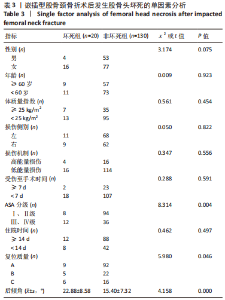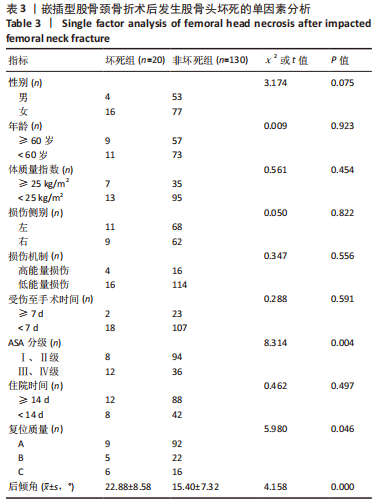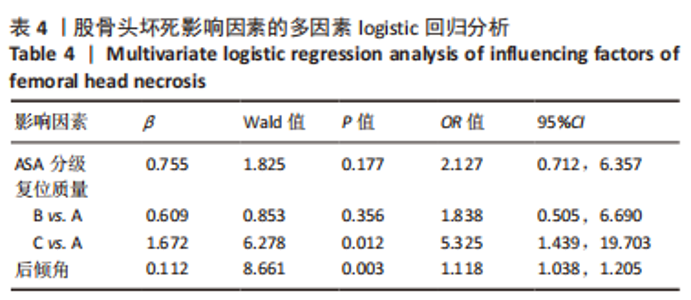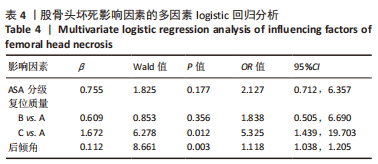Chinese Journal of Tissue Engineering Research ›› 2023, Vol. 27 ›› Issue (36): 5747-5752.doi: 10.12307/2023.758
Previous Articles Next Articles
Correlation between three-dimensional measurement of posterior tilt of impacted femoral neck fracture and femoral head necrosis
Zhan Hongqi1, 2, 3, Ma Jianxiong2, 3, Cui Shuangshuang2, Sun Lei2, 3, Wang Ying2, 3, Bai Haohao2, 3, Ma Xinlong2, 3
- 1Tianjin Medical University, Tianjin 300070, China; 2Institute of Orthopedics, Tianjin Hospital, Tianjin 300050, China; 3Tianjin Key Laboratory of Orthopedic Biomechanics and Medical Engineering, Tianjin 300050, China
-
Received:2022-10-27Accepted:2022-12-13Online:2023-12-28Published:2023-03-24 -
Contact:Ma Xinlong, Chief physician, Institute of Orthopedics, Tianjin Hospital, Tianjin 300050, China; Tianjin Key Laboratory of Orthopedic Biomechanics and Medical Engineering, Tianjin 300050, China -
About author:Zhan Hongqi, Master candidate, Tianjin Medical University, Tianjin 300070, China; Institute of Orthopedics, Tianjin Hospital, Tianjin 300050, China; Tianjin Key Laboratory of Orthopedic Biomechanics and Medical Engineering, Tianjin 300050, China -
Supported by:the National Natural Science Foundation of China, Nos. 81572154, 81871777 (to MXL); National Natural Science Foundation of China, No. 11772226 (to MJX)
CLC Number:
Cite this article
Zhan Hongqi, Ma Jianxiong, Cui Shuangshuang, Sun Lei, Wang Ying, Bai Haohao, Ma Xinlong. Correlation between three-dimensional measurement of posterior tilt of impacted femoral neck fracture and femoral head necrosis[J]. Chinese Journal of Tissue Engineering Research, 2023, 27(36): 5747-5752.
share this article
Add to citation manager EndNote|Reference Manager|ProCite|BibTeX|RefWorks
| [1] JI C, ZHU Y, LIU S, et al. Incidence and risk of surgical site infection after adult femoral neck fractures treated by surgery: A retrospective case-control study. Medicine (Baltimore). 2019;98(11):e14882. [2] CUELLAR DO, GARCIA VELEZ DA, BLEDSOE G, et al. Hybrid screw fixation for femoral neck fractures: Does it prevent mechanical failure? Injury. 2022;53(8):2839-2845. [3] CHEN W, LI Z, SU Y, et al. Garden type I fractures myth or reality? A prospective study comparing CT scans with X-ray findings in Garden type I femoral neck fractures. Bone. 2012;51(5):929-932. [4] AMSELLEM D, PARRATTE S, FLECHER X, et al. Non-operative treatment is a reliable option in over two thirds of patients with Garden I hip fractures. Rates and risk factors for failure in 298 patients. Orthop Traumatol Surg Res. 2019;105(5):985-990. [5] ZHU J, HU H, DENG X, et al. Nomogram for predicting reoperation following internal fixation of nondisplaced femoral neck fractures in elderly patients. J Orthop Surg Res. 2021;16(1):544. [6] 杜秀鹏, 杨朝晖. 65岁以下嵌插型股骨颈骨折初始畸形程度对颈缩短的影响[J]. 中国组织工程研究,2021,25(9):1410-1416. [7] ZLOWODZKI M, BRINK O, SWITZER J, et al. The effect of shortening and varus collapse of the femoral neck on function after fixation of intracapsular fracture of the hip: a multi-centre cohort study. J Bone Joint Surg Br. 2008;90(11):1487-1494. [8] DAI Y, NI M, DOU B, et al. Finite element analysis of necessity of reduction and selection of internal fixation for valgus-impacted femoral neck fracture. Comput Methods Biomech Biomed Engin. 2022;1-8. doi: 10.1080/10255842.2022.2092727. [9] FILIPPO M, DRIESSEN A, COLAROSSI G, et al. Bipolar versus monopolar hemiarthroplasty for displaced femur neck fractures: a meta-analysis study. Eur J Orthop Surg Traumatol. 2020;30(3):401-410. [10] ALHO A, BENTERUD JG, RONNINGEN H, et al. Prediction of disturbed healing in femoral neck fracture. Radiographic analysis of 149 cases. Acta Orthop Scand. 1992;63(6):639-644. [11] PALM H, GOSVIG K, KRASHENINNIKOFF M, et al. A new measurement for posterior tilt predicts reoperation in undisplaced femoral neck fractures. Acta Orthop. 2009;80(3):303-307. [12] CLEMENT ND, GREEN K, MURRAY N, et al. Undisplaced intracapsular hip fractures in the elderly: predicting fixation failure and mortality. A prospective study of 162 patients. J Orthop Sci. 2013;18(4):578-585. [13] DOLATOWSKI FC, ADAMPOUR M, FRIHAGEN F, et al. Preoperative posterior tilt of at least 20 degrees increased the risk of fixation failure in Garden-I and -II femoral neck fractures. Acta Orthop. 2016;87(3): 252-256. [14] SONG HK, CHOI HJ, YANG KH. Risk factors of avascular necrosis of the femoral head and fixation failure in patients with valgus angulated femoral neck fractures over the age of 50 years. Injury. 2016;47(12): 2743-2748. [15] OKIKE K, UDOGWU UN, ISAAC M, et al. Not All Garden-I and II Femoral Neck Fractures in the Elderly Should Be Fixed. J Bone Joint Surg Am. 2019;101(20):1852-1859. [16] SJÖHOLM P, SUNDKVIST J, WOLF O, et al. Preoperative Anterior and Posterior Tilt of Garden I-II Femoral Neck Fractures Predict Treatment Failure and Need for Reoperation in Patients Over 60 Years. JB JS Open Access. 2021;6(4):e21.00045. [17] KALSBEEK J, VAN WALSUM A, ROERDINK H, et al. More than 20° posterior tilt of the femoral head in undisplaced femoral neck fractures results in a four times higher risk of treatment failure. Eur J Trauma Emerg Surg. 2022;48(2):1343-1350. [18] YAMAMOTO T, KOBAYASHI Y, NONOMIYA H. Undisplaced femoral neck fractures need a closed reduction before internal fixation. Eur J Orthop Surg Traumatol. 2019;29(1):73-78. [19] PAPADELIS E, CHAUDHRY YP, HAYES H, et al. Evaluation of the Posterior Tilt Angle in Predicting Failure of Nondisplaced Femoral Neck Fractures After Internal Fixation: A Systematic Review. J Orthop Trauma. 2022; 2023;37(2):e89-e94. [20] SHIN WC, MOON NH, JANG JH, et al. Three-dimensional analyses to predict surgical outcomes in non-displaced or valgus impaction fractures of the femoral neck: A multicenter retrospective study. Orthop Traumatol Surg Res. 2019;105(5):991-998. [21] WANG T, SUN J, ZHA G, et al. Analysis of Risk Factors for Femoral Head Necrosis After Internal Fixation in Femoral Neck Fractures. Orthopedics. 2014;37(12):e1117-e1123. [22] PAPAPIETRO N, DI MARTINO A, NICCOLI G, et al. Trabecular metal screw implanted for avascular necrosis of the femoral head may complicate subsequent arthroplasty surgery. Eur J Orthop Surg Traumatol. 2014; 24(6):931-938. [23] LAMBERS FM, KOCH K, KUHN G, et al. Trabecular bone adapts to long-term cyclic loading by increasing stiffness and normalization of dynamic morphometric rates. Bone. 2013;55(2):325-334. [24] HOELSBREKKEN SE, DOLATOWSKI FC. The influence of the hips position on measurements of posterior tilt in a valgus-impacted femoral neck fracture. Injury. 2017;48(10):2184-2188. [25] ZAMORA T, KLABER I, ANANIAS J, et al. The influence of the CT scan in the evaluation and treatment of nondisplaced femoral neck fractures in the elderly. J Orthop Surg (Hong Kong). 2019;27(2):920543104. [26] WU S, WANG W, ZHANG B, et al. A three-dimensional measurement based on CT for the posterior tilt with ideal inter-and intra-observer reliability in non-displaced femoral neck fractures. Comput Methods Biomech Biomed Engin. 2021;24(16):1854-1861. [27] DU C, MA X, ZHANG T, et al. Reunderstanding of Garden Type I Femoral Neck Fractures by 3-dimensional Reconstruction. Orthopedics. 2013; 36(6):820-825. [28] NANTY L, CANOVAS F, RODRIGUEZ T, et al. Femoral neck shortening after internal fixation of Garden I fractures increases the risk of femoral head collapse. Orthop Traumatol Surg Res. 2019;105(5):999-1004. [29] CUI S, ZHAO L, WANG Y, et al. Blood biomarkers related to osteonecrosis of femoral head by internal fixation after Garden I femoral neck fracture: a cohort study. Injury. 2021;52(11):3427-3433. [30] MIN BW, KIM SJ. Avascular necrosis of the femoral head after osteosynthesis of femoral neck fracture. Orthopedics. 2011;34(5):349. [31] SEO GS, DIEUDONNE G, MOONEY SA, et al. Unexplained “massive osteolysis of femoral head” (MOFH) after acetabular fracture: occurrence and suggested patho-etiology. Acta Radiol. 2017;58(6): 710-718. [32] IKEMURA S, YAMASHITA A, HARADA T, et al. Clinical and imaging features of a subchondral insufficiency fracture of the femoral head after internal fixation of a femoral neck fracture: a comparison with those of post-traumatic osteonecrosis of the femoral head. Br J Radiol. 2016;89(1060):20150725. [33] STEINBERG EL, ALBAGLI A, SNIR N, et al. Addressing posterior tilt displacement during surgery to lower failure risk of sub-capital Garden types 1 and 2 femoral fractures. Arch Orthop Trauma Surg. 2022;142(8):1885-1893. [34] 张雅文, 侯国进, 周方, 等. Pauwels Ⅲ型股骨颈骨折闭合复位内固定术后缺血性股骨头坏死的多因素分析[J]. 中国微创外科杂志, 2020,20(12):1057-1062. [35] PEI F, ZHAO R, LI F, et al. Osteonecrosis of femoral head in young patients with femoral neck fracture: a retrospective study of 250 patients followed for average of 7.5 years. J Orthop Surg Res. 2020; 15(1):238. [36] SZITA J, CSERHATI P, BOSCH U, et al. Intracapsular femoral neck fractures: the importance of early reduction and stable osteosynthesis. Injury. 2002;33 Suppl 3:C41-C46. |
| [1] | Zheng Hongrui, Zhang Wenjie, Wang Yunhua, He Bin, Shen Yajun, Fan Lei. Femoral neck system combined with platelet-rich plasma in the treatment of femoral neck fracture [J]. Chinese Journal of Tissue Engineering Research, 2023, 27(9): 1390-1395. |
| [2] | Pan Zhongjie, Qin Zhihong, Zheng Tiejun, Ding Xiaofei, Liao Shijie. Targeting of non-coding RNAs in the pathogenesis of the osteonecrosis of the femoral head [J]. Chinese Journal of Tissue Engineering Research, 2023, 27(9): 1441-1447. |
| [3] | Cai Zhihao, Xie Zhaoyong. Femoral neck anteversion measurement assessment: how to establish a unified method and standard [J]. Chinese Journal of Tissue Engineering Research, 2023, 27(9): 1448-1454. |
| [4] | Qin Yuxing, Ren Qiangui, Li Zilong, Quan Jiaxing, Shen Peifeng, Sun Tao, Wang Haoyu. Action mechanism and prospect of bone microvascular endothelial cells for treating femoral head necrosis [J]. Chinese Journal of Tissue Engineering Research, 2023, 27(6): 955-961. |
| [5] | Hong Xiao, Luo Hong, Yang Ruonan. Comparison of dynamic hip screw and anti-rotation screw internal fixation and femoral neck system internal fixation in the treatment of Garden II-IV femoral neck fracture [J]. Chinese Journal of Tissue Engineering Research, 2023, 27(4): 583-587. |
| [6] | Zhao Jun, Chen Changsheng, Xu Zhonghua, Chen Hongfeng, Zhang Feng, Wang Qiuping, Zhou Jinlong, Que Yunduan. Comparison of femoral neck internal fixation system and simple cannulated screw internal fixation in the treatment of femoral neck fractures in patients under 65 years old [J]. Chinese Journal of Tissue Engineering Research, 2023, 27(36): 5823-5827. |
| [7] | Wang Tianhao, Liang Xiaolong, Zheng Kai, Li Rongqun, Zhou Jun, Geng Dechun, Xu Yaozeng, Zhu Feng. Comparison of short-term follow-up results between femoral neck system and cannulated compressive screws in the treatment of femoral neck fracture in the elderly [J]. Chinese Journal of Tissue Engineering Research, 2023, 27(36): 5828-5833. |
| [8] | Huan Dawei, Yuan Zhaofeng, Dou Weiqiang, Xia Tianwei, Qiu Yue, Zhang Chao, Shen Jirong. Changes in microcirculatory perfusion of femoral head necrosis assessed by dynamic contrast-enhanced magnetic resonance imaging [J]. Chinese Journal of Tissue Engineering Research, 2023, 27(36): 5864-5869. |
| [9] | Li Guangsheng, Lin Weimin, Zhang Shenshen, Lin Wang, Lin Chengshou. Finite element analysis of unstable intertrochanteric fractures repaired with proximal femoral nail anti-rotation combined with anterolateral reconstruction plate [J]. Chinese Journal of Tissue Engineering Research, 2023, 27(36): 5753-5759. |
| [10] | Yan Ruizhong, Li Jiahui, Lin Shuzhong, Wu Xiaogang, Guo Zhijian, Liu Wenqi, Liu Qiang. Effect of pelvic tilt on the stress at the acetabular side in standing position after total hip arthroplasty: finite element analysis [J]. Chinese Journal of Tissue Engineering Research, 2023, 27(36): 5795-5800. |
| [11] | Tian Jiaqing, He Mincong, Wei Yurou, He Xianshun, Zhong Yuan, Jiang Yulai, Zhan Zhiwei, Wei Tengfei, He Xiaoming, Wei Qiushi. Distribution law and pathological characteristics of cystic degeneration in steroid-induced femoral head necrosis [J]. Chinese Journal of Tissue Engineering Research, 2023, 27(31): 4996-5001. |
| [12] | Li Junran, Zhai Jingxiu, Zhao Hongbo, Wang Lei, Wang Hongrun, Liang Junsheng, Li Ligeng. Assistance of traction table for total hip arthroplasty through the direct anterior approach for treating femoral neck fracture in the elderly [J]. Chinese Journal of Tissue Engineering Research, 2023, 27(27): 4312-4317. |
| [13] | Li Daen, Wu Yafei, Qiu Shang, Wang Gang, Gao Xuren, Chen Xiangyang. Factors associated with subscapularis injury and predictive efficacy based on three-dimensional CT reconstruction [J]. Chinese Journal of Tissue Engineering Research, 2023, 27(27): 4351-4356. |
| [14] | Guo Sutong, Guo Yu, Wang Ling, Ding Yujian, Ren Tianhao, Xu Haitao, Wang Yulin, Feng Dehong. Finite element analysis of hip stress distribution at different hip abduction angles in patients with developmental dysplasia of the hip [J]. Chinese Journal of Tissue Engineering Research, 2023, 27(27): 4265-4270. |
| [15] | Xu Biao, Lu Tan, Yang Junliang, Jiang Yaqiong, Yin Yujiao. Three-dimensional finite element analysis of the stress of the patellofemoral joint after medial patellofemoral ligament reconstruction by different femoral reconstruction insertion points [J]. Chinese Journal of Tissue Engineering Research, 2023, 27(22): 3463-3468. |
| Viewed | ||||||
|
Full text |
|
|||||
|
Abstract |
|
|||||









